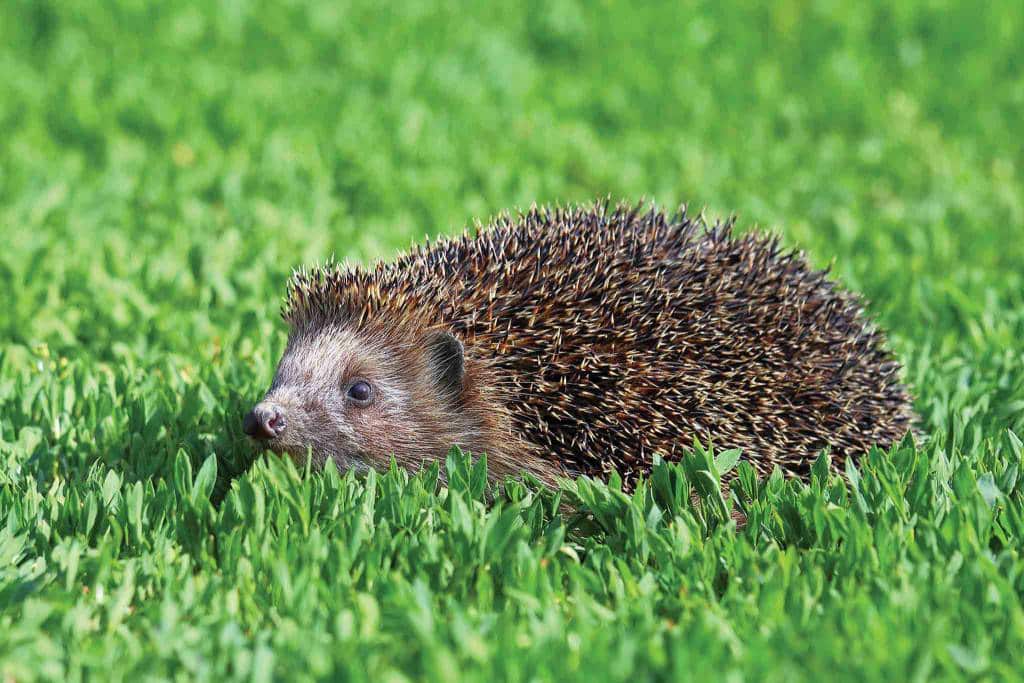By Hannah Stephenson
Many worms, beetles, slugs, caterpillars and millipedes – which form the hedgehog’s natural diet – have been killed off by chemical treatments and intensive farming methods. Badgers also compete for the same food.
A recent wildlife survey by the RSPB found that the number of people who have never seen a hedgehog in their garden rose to 24 per cent last year. And as hedgerows and the countryside which forms their natural habitat dwindles, so the garden becomes ever more important as a hedgehog haven.
So what can we do to save this prickly garden favourite? The Wildlife Trusts advises:
- Create hedgehog highways: They need plenty of access to search for food, nesting sites and mates. Cut a 13cm-squared hole in your fence or dig a channel under garden boundaries to allow them to wander and get your neighbours to do the same.
- Provide nesting sites: Log and leaf piles, wilderness areas and purpose-built hedgehog homes are ideal places for hedgehogs to nest and hibernate. Fallen leaves make the perfect nesting material, so don’t clear all of these away in autumn. Pile them in quiet, undisturbed corners of your garden to allow hedgehogs a safe, secure area to breed and hibernate.
- Avoid slug pellets: Hedgehogs hoover up more than 100 invertebrates such as snails, slugs and worms every night, so no need to use slug pellets.
- Cover drains and gullies: Hedgehogs have poor eyesight, but are quite curious, meaning they fall into holes and get stuck, so cover up any open drains and gullies. If you have a pond, make sure you provide an access point so hedgehogs can climb back out – create a slope with stones or other material.
- Grow a wide variety of plants: Attract plenty of natural hedgehog food by keeping your garden diverse with a wide variety of habitats. Mulching beds with garden compost will encourage earthworms, woodlice and beetles as it begins to rot down, while wood piles encourage a rich feast of earwigs, centipedes and woodlice. Let your grass grow a little wild and leave some leaf litter – both are important homes for the hedgehog’s prey, including ground beetles and leatherjackets.
- Check bonfires: Every year, hedgehogs die under bonfire piles that have not been checked before being lit. The British Hedgehog Preservation Society advises avoiding building your bonfire until the day it is going to be lit to reduce the chances of hedgehogs hibernating in the bonfire pile. Always build your bonfire on clear ground (not on top of leaf litter) and check for hedgehogs before lighting.
- Set up a feeding station: Cut a clear hole in a plastic storage box and weigh down the lid with bricks to stop cats and foxes taking the food. If you are worried about attracting rats, don’t put out grain-based foods and take in any excess food when your hedgehog has visited.

THE BRITISH HEDGEHOG PRESERVATION SOCIETY ALSO ADVISES
- Take care when turning compost: The compost heap is another ideal place for a hedgehog to make a nest and rear its young. When turning the heap, one thrust of a fork can easily kill more than one baby hedgehog. The safest time to spread the heap is probably October or November, when most babies have left their mothers and adults have not yet started to hibernate. Partly used bags of compost may also have nesting hedgehogs in them.
- Repair fences: Mend wooden fences that blow down in the wind as soon as possible or hedgehogs may be tempted to make their nests underneath them. Leave a hole in fences or newly constructed walls so hedgehogs can come and go. Use environmentally-safe wood preservatives on sheds and fences as hedgehogs often lick new smells or substances – your garden centre should be able to advise.
- Netting: Keep all pea-netting a foot above the ground so hedgehogs can go under it and will not try to go through it and become stuck. The same applies to tennis nets and football nets.
- Feed them: Ensure they have a fresh supply of water available – especially in very hot weather – and leave a dish of dog food in a place where the hedgehog can get it, but not the local cats.
For more information go to www.britishhedgehogs.org.uk and www.wildlifetrusts.org/hedgehogs
TIPS AND TREATS FOR THE REST OF YOUR SUMMER GARDEN
- Best of the bunch: Crocosmia. These stunning South African perennials, with their sword-like leaves and spikes of sizzling flowers in brilliant yellows, oranges and hot reds, look fantastic in the late summer garden alongside other showstoppers including heleniums and asters. They naturalise quickly, however, and some can be invasive, so you may have to lift and divide them regularly to avoid them taking over a border. They prefer full sun and damp soil. Good varieties include C. Severn Sunrise, which produces a compact, upright blaze of orange flowers, C. x crocosmiiflora Solfatare which produces vibrant yellow blooms, and C. Lucifer – an impressive 1.2m type which bears vibrant red flowers, although you may need to support them to stop them flopping.
- Good enough to eat: Spring onions. These little fiery rockets of flavour can add heat to salads, dips, salsas and stir-fries and are really easy to grow. Sow a short row every three to four weeks from spring to mid-summer, thin them to 2.5cm apart, allowing 15cm between rows. Keep them watered in dry spells, weed regularly and make sure the soil is kept evenly moist when growing. You can use the thinnings of spring onions as you would chives, then pull alternate plants as baby spring onions. Those left to grow can be used as mild onions. Varieties worth trying include North Holland Blood Red and White Lisbon.








